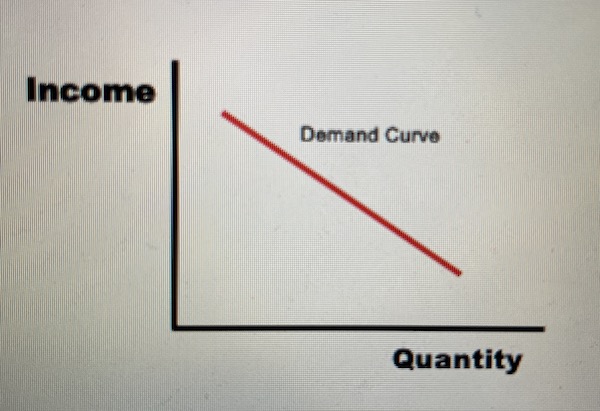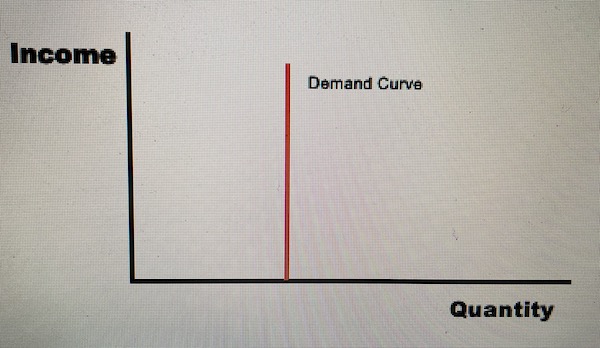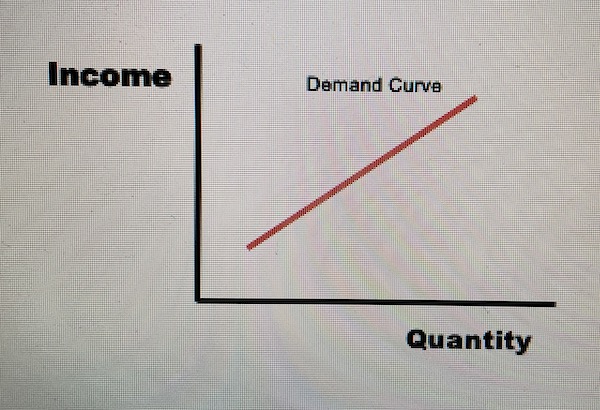This article is about Income Elasticity of Demand (YED).
It defines, calculates and interprets Income Elasticity of Demand (YED) as well as explains the factors that determine Income Elasticity of Demand (YED) and its impact on company revenue. The graphs illustrate various stages of Income Elasticity of Demand (YED).
What is Income Elasticity of Demand (YED)?
Income Elasticity of Demand (YED) measures how a change in income affects quantity demanded. Simply, how much demand for a product decreases or increases following an increase or decrease in customers’ income.
How to calculate Income Elasticity of Demand (YED)?
Income Elasticity of Demand (YED) is calculated using the following equation:
| %∆ Change in Quantity Demanded | |
| Income Elasticity of Demand (YED) = | ━━━━━━━━━━━━━━━━━━━━━━━━━━━━━━━━━━━━━━ |
| %∆ Change in Income |
Where:
| Final Value – Original Value | ||
| %∆ Change = | ━━━━━━━━━━━━━━━━━━━━━━━━━━━━━━ | x 100 |
| Original Value |
NOTE: The final value of Income Elasticity of Demand (YED) is usually either negative or positive.
Different Types of Income Elasticity of Demand (YED)
Income Elasticity of Supply (YES) is used to show the relationship that exists between consumers’ income and the demand for a product.
It measures the responsiveness of demand for a product after a change in consumer income.
Income Elasticity of Supply (YES) can be either:
- Negative
- Zero
- Positive.
The following descriptions of elasticities start from the situation when percentage change in consumer income has completely no effect on quantity demanded until the situation when even a tiny change in consumer income has a huge effect on quantity demanded.
Income Elasticity of Demand (YED) also gives us more information about the nature of the good whether it is a normal good or an inferior good. Income elasticity can be described for three classes of goods.
1. Negative (YED < 0)
Value of Income Elasticity of Demand (YED) lower than 0. The product is to have negative Income Elasticity of Demand (YED). This means a change in consumer income has a strong effect on demand for the product.
Comment: The Income Elasticity of Demand (YED) is negative for inferior goods. Demand for these products falls as consumer income levels rise. Higher levels of income reduce demand for inferior goods. Because as income increases consumers are choosing to buy substitutes that are better and more expensive. However, demand for these products grows as consumer income levels fall. Lower levels of income increase demand for inferior goods. Because as income decreases consumers are not choosing to buy substitutes that are better and more expensive.
Examples of products: Examples of inferior goods and services could include rice, frozen vegetables, public transport, second-hand goods such as furniture or clothes, ‘economy’ own-brand food products, poorer cuts of meat, weekend breaks in own country rather than long holidays abroad, etc.
How consumers behave? Consumers will respond to a change in their income. They will purchase more inferior goods such as supermarket’s own-label products and less of expensive well-known branded products.
Chart:

Calculations: Consumer income increased by 20%. The demand for a supermarket’s own-label breakfast cereal decreased by 10%. What is the Income Elasticity of Demand (YED) for this product?
Step 1: Calculate the percentage change in Quantity Demanded.
%∆ Change in Quantity Demanded = -10%
Step 2: Calculate the percentage change in Income.
%∆ Change in Income = 20%
Step 3: Use the YED formula:
Income Elasticity of Demand (YED) = -10% / 20% = -0.5
It is now important to explain this result. An Income Elasticity of Demand (YED) of -0.5 means that demand changes by -0.5% for every 1.0% change in income.
What should the business do? The producers and retailers of inferior products may actually gain during a recession. A recession is when output in the economy falls for two consecutive quarters. This will lead to lower consumer incomes as unemployment increases. The producers and retailers of inferior products may actually lose during an economic growth. A growth stage is when output in the economy continues increasing. This will lead to higher consumer incomes as unemployment decreases. If a firm faces this kind of elasticity of income, it can start or increase production of inferior goods when the economy is contracting, and stop or decrease production of inferior goods when the economy is expanding.
2. Income Elasticity of Demand (YED) = 0
Value of Income Elasticity of Demand (YED) equals 0. This means a change in consumer income has no effect on demand for the product.
Comment: The Income Elasticity of Demand (YED) is zero for goods that are highly necessary, indispensable. Demand for these products does not change as consumer income levels rise. Higher level of income does not reduce nor increase demand for those products.
Examples of products: Highly necessary goods which are not sensitive to income for their demand. Consumers will buy them for sure regardless of income. Both poor people and rich people will need products such as salt to make their food tastier. The same with toilet paper – no matter how rich or poor you are, you will still use it.
How consumers behave? Consumers will not respond at all to a change in their income. They will purchase those products anyway regardless of how much income they have.
Chart:

Calculations: Consumer income decreased by 30%. The demand for the product did not change and the same quantity was sold. What is the Income Elasticity of Demand (YED) for this product?
Step 1: Calculate the percentage change in Quantity Demanded.
%∆ Change in Quantity Demanded = 0%
Step 2: Calculate the percentage change in Income.
%∆ Change in Income = -30%
Step 3: Use the YED formula:
Income Elasticity of Demand (YED) = 0% / -30% = 0
It is now important to explain this result. An Income Elasticity of Demand (YED) of 0 means that demand changes by 0% for every 1.0% change in income.
What should the business do? The producers and retailers of highly necessary products will neither lose nor gain during recessions and economic growths. An increase or decrease in disposable income of customers will have absolutely zero effect on how much they consume. There will be no impact of rising or declining household income on the production of goods with Income Elasticity of Demand (YED) equal zero. Both high-income consumers and low-income consumers will need them in the same quantity.
3. Positive (YED > 0)
Value of Income Elasticity of Demand (YED) higher than 0. The product is to have positive Income Elasticity of Demand (YED). This means a change in consumer income has a strong effect on demand for the product.
Comment: The Income Elasticity of Demand (YED) is positive for normal goods. There are two types of normal goods including necessities and luxuries. Demand for these products increase as consumer income levels rise. Higher levels of income increase demand for normal goods including both necessary products and luxury products Because as income increases consumers will buy more of those products. However, demand for these products declines as consumer income levels fall. Lower levels of income decrease demand for normal goods. Because as income decreases consumers are not choosing to buy them.
A. Necessities: These are products which are needed. Income Elasticity of Demand (YED) for necessities is positive between 0 and 1. If consumer income increases, they will buy more, but demand rises only a little as people can only have so much. This means a change in income has little effect on the demand of a good – demand for these goods will increase, but by a small proportion. The demand is responsive, but not highly responsive to changes in income levels.
B. Luxuries: These are products which are wanted, highly desirable. Income Elasticity of Demand (YED) for luxuries is positive higher than 1. If consumer income increases, they will buy much more as the demand for these goods will rise by an even greater proportion as consumers may already be purchasing sufficient quantities of normal goods. This means a change in income has strong effect on the demand of a good – demand for these goods will increase by a large proportion. The demand is highly responsive to changes in income levels.
Examples of products: Examples of necessities include fresh fruits and vegetables, railway tickets, toothpaste, soap, pharmaceutical products, etc. as well as non-branded products. Examples of luxuries include fine wine, sports cars, golden wristwatches, designer clothes, smartphones, holidays abroad, etc. as well as branded products.
How consumers behave? Consumers will respond to a change in their income. They will purchase more normal goods and less of inferior goods. Producers of necessities will not experience sharp increases in demand when incomes are rising during economic growth, but neither will the demand for them fall greatly when consumer incomes decline.
Chart:

Calculation 1: Consumer income increased by 20% and the demand for potatoes increases by 10%. What is the Income Elasticity of Demand (YED) for this product which is a necessity?
Step 1: Calculate the percentage change in Quantity Demanded.
%∆ Change in Quantity Demanded = 10%
Step 2: Calculate the percentage change in Income.
%∆ Change in Income = 20%
Step 3: Use the YED formula:
Income Elasticity of Demand (YED) = 10% / 20% = 0.5
It is now important to explain this result. An Income Elasticity of Demand (YED) of 0.5 means that demand changes by 0.5% for every 1.0% change in income.
Calculation 2: Consumer income increased by 20% and the demand for luxury holidays in Bali increases by 100% from once a year to twice a year%. What is the Income Elasticity of Demand (YED) for this product which is a luxury?
Step 1: Calculate the percentage change in Quantity Demanded.
%∆ Change in Quantity Demanded = 100%
Step 2: Calculate the percentage change in Income.
%∆ Change in Income = 20%
Step 3: Use the YED formula:
Income Elasticity of Demand (YED) = 100% / 20% = 5
It is now important to explain this result. An Income Elasticity of Demand (YED) of 5 means that demand changes by 5.0% for every 1.0% change in income.
What should the business do? The producers and retailers of normal goods both necessities and luxurieswill gain during an economic growth. A growth stage is when output in the economy continues increasing. This will lead to higher consumer incomes as unemployment decreases. If a firm faces this kind of elasticity of income, it can start or increase production of normal goods when the economy is expanding, and stop or decrease production of inferior goods when the economy is contracting. In fact, the producers of luxuries will gain much more during an economic growth than the producers of necessities. But, the producers of necessities will lose much less during a recession than the producers of luxuries. A recession is when output in the economy falls for two consecutive quarters. This will lead to lower consumer incomes as unemployment increases.
Income Elasticity of Demand (YED) and Sales Revenue
Let’s see how to apply Income Elasticity of Demand (YED) into real business situations to help the business increase sales.
Business managers can predict future sales using Income Elasticity of Demand (YED). It is because different products are less income sensitive than others so are less prone to changes in demand during an economic recession.
The Income Elasticity of Demand (YED) calculations can also be incorporated into the business’ marketing strategy. Businesses are interested in the value of Income Elasticity of Demand (YED) for their products, so that they can make sales forecasts of the level of demand. When the economy grows, income rises, hence demand for certain products also rises. When the economy shrinks, income declines, hence demand for certain products also declines.
- When consumer income declines (↓), they buy more of inferior goods and less of normal goods, especially luxuries. Sales revenue will increase when the business produces inferior goods during economic downturn.
- When consumer income rises (↑), they buy more of normal goods, especially luxuries, and less of inferior goods. Sales revenue will increase when the business produces luxuries during economic upturn
Therefore, different businesses will have varied experience resulting from economic growth – the rising consumer incomes that accompany it will not be evenly felt by all companies. Some businesses will experience substantial increases in the demand for their products (luxuries), others will notice a more limited rise (necessities), and some will see their demand actually fall for particular product categories (inferior goods).
The determinants of Income Elasticity of Demand (YED)
There are many influences on Income Elasticity of Demand (YED):
- Existence of different market segments. Income is a popular base for demographic market segmentation. Different markets segments where customers have different levels of income are going to experience different values of Income Elasticity of Demand (YED). Companies selling to the wealthy people will primarily deal with positive Income Elasticity of Demand (YED) while firms which focus on marketing products directly to consumers with relatively low incomes will be dealing with negative Income Elasticity of Demand (YED). Companies will use different pricing strategies for different consumer groups.
- Time. Usually, the longer the time, the more ’normal’ a good becomes. What might be considered a luxury among young people who are just starting their first job is not necessarily a luxury for a middle-aged well-established family with high double income and robust personal wealth. Also, when a good is immediately required it may be less of a normal good with YED between 0 and 1, and more of a necessity with YED below 0.
- People regard ’luxury’ and ’necessity’ differently. During an economic growth when customers have higher income, the demand for luxuries increases. Some companies may tend to promote necessities differently to give them a more luxurious image. In this way, by changing the perception of customers towards a product, people will regard necessary products as more sophisticated ones. Research proves that a good is regarded as more luxurious, if it is an object of desire rather than just used for relieving a state of discomfort or solving a daily problem. On another hand, during the times of economic recession when customers have lower income, the demand for necessities increases. Hence, luxuries could be promoted as necessary products to have in order to maintain sales.
Summary
Income Elasticity of Demand (YED) looks at how consumer income changes affect demand.
It is useful for companies to predict future sales during different economic cycles. Certain products are less income sensitive than others so are less prone to changes in demand during an economic recession. While other products are more prone to changes in demand during an economic slowdown, but tend to perform better during an economic boom.
 Articles: 1,400 · Readers: 740,000 · Views: 2,209,961
Articles: 1,400 · Readers: 740,000 · Views: 2,209,961 